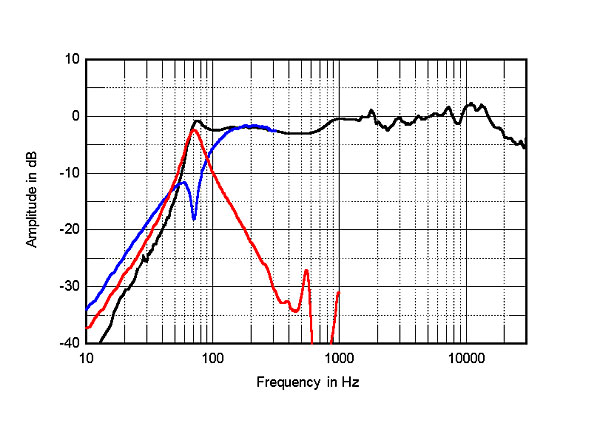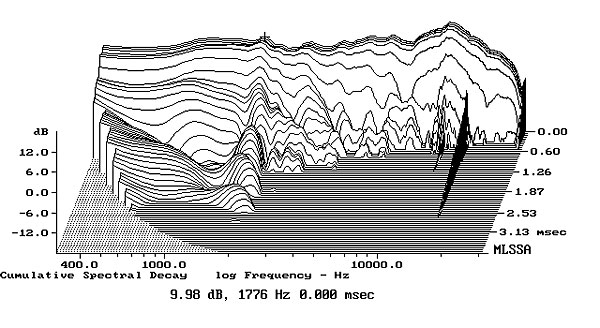This is a review and detailed measurements of the Pioneer SP-BS22-LR desktop/bookshelf budget speakers. I purchased them recently from Amazon for US $118 including Prime shipping. But I hear they go on sale for much less money.
The build quality is incredible given the very low price:

The enclosure is rather tall but not very heavy. I was pleasantly surprised by the nice, high quality binding posts in the back:

The curved cabinet is an excellent touch and one that is expected on high-end speakers. There is no sloppy glue and such as I have seen on some drivers on budget speakers.
Measurements are performed using the Klippel Near-field Scanner (NFS). This is a robotic measurement system that analyzes the speaker all around and is able (using advanced mathematics) to subtract room reflections. It also measures the speaker at close distance ("near-field") which sharply reduces the impact of room noise. Both of these factors enable testing in ordinary rooms yet results that can be more accurate than anechoic chamber. In a nutshell, the measurements show the actual sound coming out of the speaker independent of the room.
Spinorama Audio Measurements
Acoustic measurements can be grouped in a way that can be perceptually analyzed to determine how good a speaker can be used. This so called spinorama shows us just about everything we need to know about the speaker with respect to tonality and some flaws:

We like to see flat on-axis response as indicated by my arrow in red. Below about 1 kHz we are surprisingly close to that. The crossover frequency is at 3 kHz and we can see peaking of the response before it, and droop after it.
Early reflections though are smooth (in dashed blue) so that is good.
Zooming into "directivity index" tells us how close the direct sound of the speaker is relative to what hits all the other surfaces and then arrives at our ear:

We see some deviations above 2 kHz but not bad for a budget speaker.
If you were to put these in a room (as opposed to desktop), this is the predicted frequency response/tonality of the speaker where we mix the direct sound with reflections:

Deviations are small meaning this is more of a neutral speaker.
Basic Speaker Measurements
Here is the impedance (and phase) of the speaker relative to frequency:

Anytime there is a kink/little wiggle in the response, it indicates a resonance. We have at least a couple of these, one around 280 Hz and another at 1.6 kHz. The former is not showing up in the frequency response measurement so not material. There are some peaks around 1 kHz in the frequency response which means they are more material than what we are seeing here.
Here are distortion measurements which are supposed to be done in anechoic chamber but were not (so ignore data below 200 Hz or so):


Advanced Speaker Measurements

Notice that the early reflections are smoother than on-axis. Translation: don't follow the mob on the Internet and put absorbers everywhere.

I reduced the number of graphs here to better highlight the ones that are likely to be at play in your listening room:

On the left I have highlighted 20 and 30 degrees which would show the response if you did NOT toe in the speaker to point at your ear.


Eye-candy Speaker Measurements
Here is the soundfield from the speaker at crossover frequency of 3000 Hz:

If you had an ideal, full-bandwidth driver, you would get one balloon pointing at the listener. But due to interference between the tweeter and woofer, you have three speakers playing at once! One at your ear and then one point up and another pointing down.
Full spin data is enclosed.
Informal Listening Tests
My first impression was positive, listening to what was mostly a balanced response. In a few minutes though, I found the speaker bright a bit due to lack of deep bass. I toed the speaker away from my ears and that made a drastic difference, balancing the tonality considerably. Compared to my JBL LSR305P Mark II, the JBL had much better bass but otherwise had similar tonality which is to say the Pioneer was doing well. Let me backtrack that a bit: there is a bit too much mid-range in the pioneer.
On loudness test, deep lows play a bit but then the speaker falls apart drastically, getting super distorted. Techno music with higher frequency bass was handled much better. If you have an option of cutting out the very lows in your playback software, I would do that.
Conclusions
I remember meeting Andrew Jones at CES years ago when he had first brought out these (or was it the older generation) ones. I asked him what made them sound good and he said: "people making budget speakers put in 10 cent parts. I spend $1 and that makes a big difference!" Naturally there is more there in the form of a skilled designer than typical budget speaker.
Overall, the mission is accomplished in designing a speaker that is not offensive despite its low cost. It looks good and seems to perform well.
------------
As always, questions, comments, recommendations, etc. are welcome.
It is half hour before midnight as I am typing this review. For some odd reasons, the TV networks play all these food commercials making me hungry for some lobster! Please donate a few dollars so I can get some tomorrow using: https://www.audiosciencereview.com/forum/index.php?threads/how-to-support-audio-science-review.8150/
The build quality is incredible given the very low price:
The enclosure is rather tall but not very heavy. I was pleasantly surprised by the nice, high quality binding posts in the back:
The curved cabinet is an excellent touch and one that is expected on high-end speakers. There is no sloppy glue and such as I have seen on some drivers on budget speakers.
Measurements are performed using the Klippel Near-field Scanner (NFS). This is a robotic measurement system that analyzes the speaker all around and is able (using advanced mathematics) to subtract room reflections. It also measures the speaker at close distance ("near-field") which sharply reduces the impact of room noise. Both of these factors enable testing in ordinary rooms yet results that can be more accurate than anechoic chamber. In a nutshell, the measurements show the actual sound coming out of the speaker independent of the room.
Spinorama Audio Measurements
Acoustic measurements can be grouped in a way that can be perceptually analyzed to determine how good a speaker can be used. This so called spinorama shows us just about everything we need to know about the speaker with respect to tonality and some flaws:
We like to see flat on-axis response as indicated by my arrow in red. Below about 1 kHz we are surprisingly close to that. The crossover frequency is at 3 kHz and we can see peaking of the response before it, and droop after it.
Early reflections though are smooth (in dashed blue) so that is good.
Zooming into "directivity index" tells us how close the direct sound of the speaker is relative to what hits all the other surfaces and then arrives at our ear:
We see some deviations above 2 kHz but not bad for a budget speaker.
If you were to put these in a room (as opposed to desktop), this is the predicted frequency response/tonality of the speaker where we mix the direct sound with reflections:
Deviations are small meaning this is more of a neutral speaker.
Basic Speaker Measurements
Here is the impedance (and phase) of the speaker relative to frequency:
Anytime there is a kink/little wiggle in the response, it indicates a resonance. We have at least a couple of these, one around 280 Hz and another at 1.6 kHz. The former is not showing up in the frequency response measurement so not material. There are some peaks around 1 kHz in the frequency response which means they are more material than what we are seeing here.
Here are distortion measurements which are supposed to be done in anechoic chamber but were not (so ignore data below 200 Hz or so):
Advanced Speaker Measurements
Notice that the early reflections are smoother than on-axis. Translation: don't follow the mob on the Internet and put absorbers everywhere.
I reduced the number of graphs here to better highlight the ones that are likely to be at play in your listening room:
On the left I have highlighted 20 and 30 degrees which would show the response if you did NOT toe in the speaker to point at your ear.
Eye-candy Speaker Measurements
Here is the soundfield from the speaker at crossover frequency of 3000 Hz:
If you had an ideal, full-bandwidth driver, you would get one balloon pointing at the listener. But due to interference between the tweeter and woofer, you have three speakers playing at once! One at your ear and then one point up and another pointing down.
Full spin data is enclosed.
Informal Listening Tests
My first impression was positive, listening to what was mostly a balanced response. In a few minutes though, I found the speaker bright a bit due to lack of deep bass. I toed the speaker away from my ears and that made a drastic difference, balancing the tonality considerably. Compared to my JBL LSR305P Mark II, the JBL had much better bass but otherwise had similar tonality which is to say the Pioneer was doing well. Let me backtrack that a bit: there is a bit too much mid-range in the pioneer.
On loudness test, deep lows play a bit but then the speaker falls apart drastically, getting super distorted. Techno music with higher frequency bass was handled much better. If you have an option of cutting out the very lows in your playback software, I would do that.
Conclusions
I remember meeting Andrew Jones at CES years ago when he had first brought out these (or was it the older generation) ones. I asked him what made them sound good and he said: "people making budget speakers put in 10 cent parts. I spend $1 and that makes a big difference!" Naturally there is more there in the form of a skilled designer than typical budget speaker.
Overall, the mission is accomplished in designing a speaker that is not offensive despite its low cost. It looks good and seems to perform well.
------------
As always, questions, comments, recommendations, etc. are welcome.
It is half hour before midnight as I am typing this review. For some odd reasons, the TV networks play all these food commercials making me hungry for some lobster! Please donate a few dollars so I can get some tomorrow using: https://www.audiosciencereview.com/forum/index.php?threads/how-to-support-audio-science-review.8150/
Attachments
Last edited:



